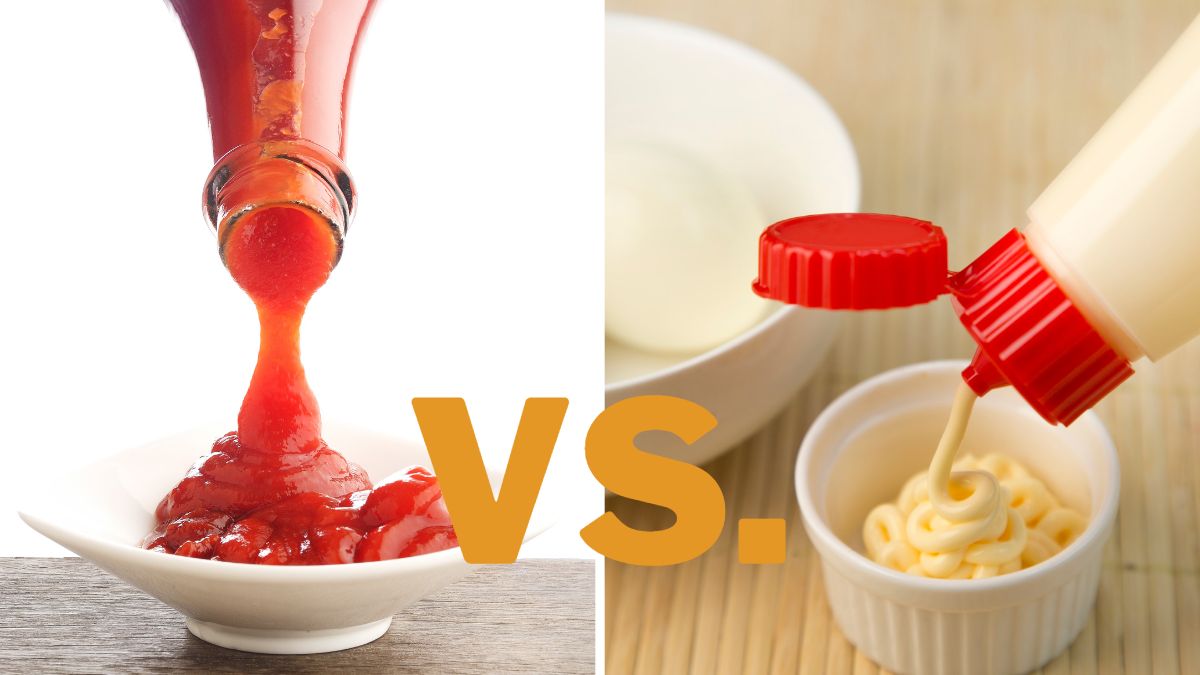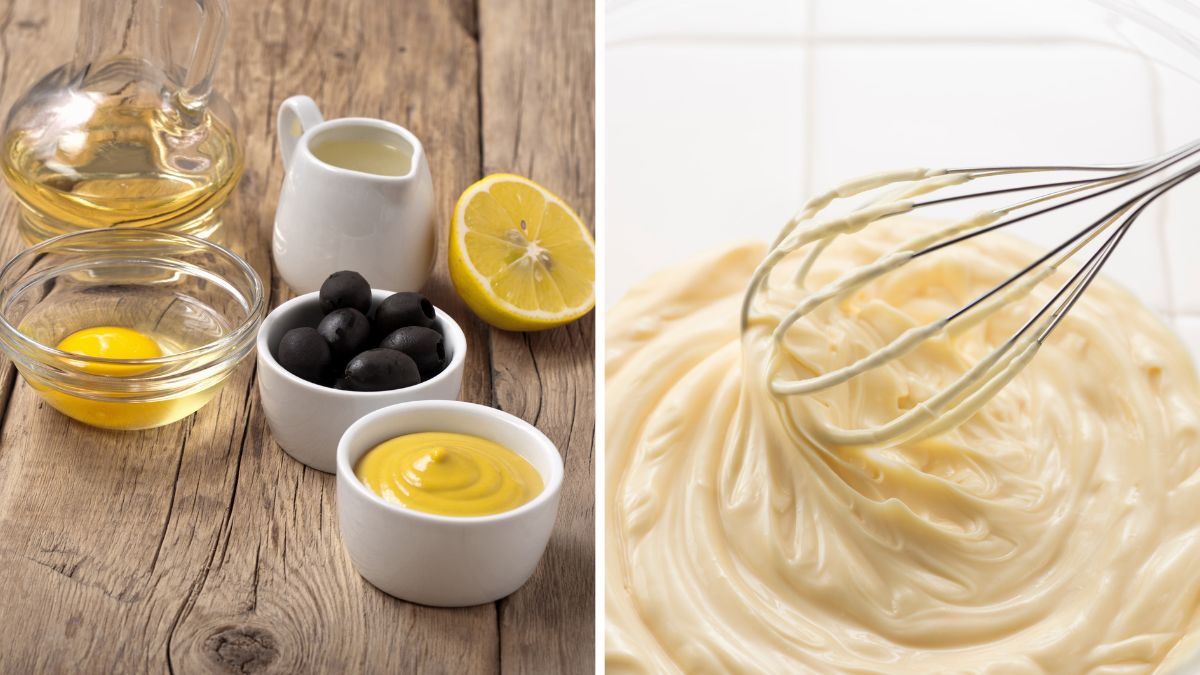Ketchup vs. Mayo: Differences & Which Is Better

Ketchup and mayo are probably the best pair in the history of food. They go perfectly together in burgers, sauces, and flavor-improving combinations. The differences between ketchup and mayo are in color, taste, and texture, and yet when we think of mayo, we instantly think of ketchup. The differences between them go beyond taste and color. So, what are the differences between ketchup and mayo?
Mayo is made with egg yolks, oil, water, mustard, lemon zest, and vinegar. Ketchup is made from tomatoes, salt, onions, vinegar, and corn syrup. Mayo is made by whipping the ingredients together until you get the consistency. Ketchup requires cooking.
Knowing the differences between mayo and ketchup is very important so that you can use both in the best ways. Even though you can use both or interchange them in many cases, mayo and ketchup often call for different uses. In the following paragraphs, I will explain the differences between ketchup and mayo, how they are made, their nutritional differences, as well best use.
Ingredients
Mayo is made with egg yolks, oil, water, mustard, lemon zest, and vinegar. Mayo is much greasier than ketchup and far more perishable. On an industrial scale, mayo contains shelf-life-prolonging additives that make it more durable, but homemade mayo is far more perishable.
Ketchup predominantly consists of tomatoes, onions, sugar, salt, corn syrup, and vinegar. Ketchup is not as greasy as mayo, but it is significantly sweeter due to the corn syrup and the sugar. Homemade ketchup is more durable than homemade mayo and mass-produced; it is even more durable than factory-produced mayo.
Making
While you need to cook the tomatoes to make ketchup, you don’t thermally process mayo. The trick to making good mayo is to whip it thoroughly and add the ingredients in a particular order. The yolks, salt, mustard, and lemon juice go first.
Once they start getting foamy, you slowly add the oil, and in the end, you add the vinegar to make the entire mixture more stable and balance out the flavors. The making process of the mayo is called cold processing, which is processing at temperatures lower than room temperature.
On an industrial scale, cold processing takes place at temperatures under 5 °C (40 °F), while homemade mayo is made at somewhere below room temperature.

Ketchup, on the other hand, goes through thermal processing. To make the ketchup, you need to cook the tomatoes first. The cooking of the tomatoes is the key step in the ketchup-making process, whereby the rest of the ingredients are added in no particular order.
Factory-produced ketchup contains corn syrup and a substantial amount of sugar. Homemade ketchup doesn’t have to include corn syrup, and the amounts of sugar are significantly lower.
Mayo is creamier in consistency, and it doesn’t drip but slide from a spoon. On the other hand, ketchup is runnier and less creamy than mayo ketchup and is also much more variable than mayo, depending on the recipe used.
Both homemade ketchups, as well as factory-produced ketchup, can be thinner and thicker, as well as vary in terms of use.
Pasta ketchup is usually thinner, and burger ketchup is thicker and creamier. Mayo is not a variable in consistency and thickness. Mayo varies in flavors, as there are mayos tasting like garlic barbecue etc.
Nutrition
Neither ketchup nor mayo is what you would call healthy, but they are not harmful in moderate amounts. Ketchup is, of course, healthier than mayo, but still, it hardly contains any of the tomato nutritional elements, and it does contain sugar.
Mayo is way greasier and fattier than ketchup. Because it contains egg yolks, it contains a significant amount of cholesterol. Nevertheless, mayo is keto-friendly, while ketchup is packed with carbohydrates.
Uses
Since ketchup and mayo go perfectly together, they share many of their uses. They are both widely used in fast food, along with mustard. Mayo and ketchup are the base for many sauces for burgers, hot dogs, pizza toppings, and finger food sauces.
Ketchup has a predominant use in pasta sauces and cooking in general as a flavor-giving ingredient to bland sauces or gravies. Also, ketchup is almost exclusively used for pizza.
Ketchup gets absorbed into the dish; it is combined with enriching and changing the taste. On the other hand, mayo is used for salad dressings, whereas ketchup is not used that way.
Mayo doesn’t do well when cooked, as it doesn’t melt nor penetrate the food. The greasy molecules of the mayo don’t get absorbed by the food, so you are left with somewhat runny mayonnaise on your food.
Mayo works best cold, whereas ketchup works both cold and hot. Countless sauce recipes call for ketchup and mayo, so their applications are vast.

Taste
Mayo and ketchup taste entirely different. Ketchup is sweet, salty, and a little tangy. It is refreshing and zingy. Mayo is delicious but much heavier than ketchup, and you can’t eat much of it as you will get sick to your stomach.
Mayo is creamier than ketchup and bitterer due to the lemon juice and the mustard inside. Mayo smells somewhat heavy. The yolks dominate the mayo aroma, as well as the oil. Although the lemon and mustard have the strongest aromas of all mayo ingredients, they aren’t that noticeable.
Ketchup smells inviting and opens up your appetite. It smells like tomatoes, herbs, and sugar; you can taste it just by smelling it, which isn’t the case with mayo. If you haven’t tried it, chances are, you won’t want to after you smell it, so it isn’t as inviting as ketchup.
Popularity
Both ketchup and mayo are very popular and have an audience worldwide. Ketchup is more popular in Europe and Asia, while mayo is the number one condiment in the USA.
Generally, both are loved and known worldwide and work very well together and separately. Ketchup is more dominant in vegetarian and vegan cuisine, while mayo is more popular in carnivorous cuisines, though there are vegetarian/vegan varieties.
Varieties
Although both ketchup and mayo have varieties, ketchup is more variable than mayo. Ketchup varies in terms of flavor, consistency, and texture. There are also hot and mild ketchup varieties.

Mayo doesn’t vary much in terms of texture or density, but it has vegan/vegetarian versions. Also, the mayo variations mainly encompass different flavors.
Ketchup or Mayo: Which Is Better?
Both ketchup and mayo are delicious, which is why they are so popular. To say that one is better would be wrong, as they work together excellently and have individual uses.
If you are more inclined toward fresher and lighter meals, you can garnish them with ketchup, but if you like greasier food, mayo is your go-to guy. If you like sauces and dips, both work great, depending on your preference. You can use either or both.
For salads, use mayo as a dressing or a dressing ingredient, while pasta and pizza go almost exclusively with ketchup.
Is Ketchup Healthier than Mayonnaise?
Ketchup is healthier than mayonnaise, although neither is healthy in large quantities. Ketchup hardly has any of the tomatoes’ nutritional qualities as the tomatoes are cooked to make the ketchup. Moreover, it contains a lot of sugar and is loaded with carbs.
Mayo is way greasier than ketchup, which is why ketchup wins in this regard; it is packed with cholesterol and fat.
In general, you should pace yourself with both ketchup and mayonnaise; don’t eat too much too often.
What Has More Salt: Ketchup, or Mayonnaise?
Ketchup has more salt than mayonnaise. Ketchup has approximately 900 mg salt per 100 gr. Ketchup, whereas mayonnaise, has 630 mg salt per 100 gr mayonnaise. So ketchup has almost a third more salt than mayonnaise. [1] [2]
